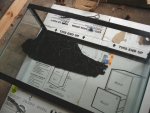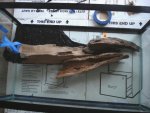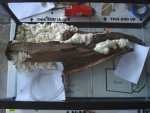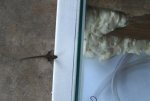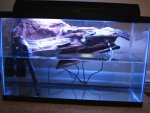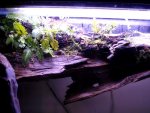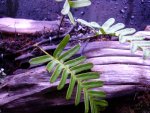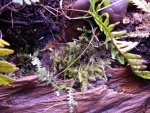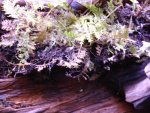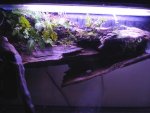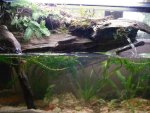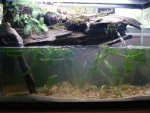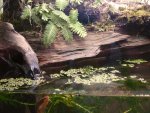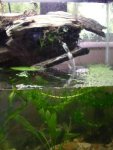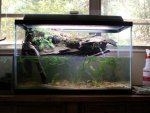slowfoot
New member
- Joined
- Oct 12, 2007
- Messages
- 665
- Reaction score
- 29
- Points
- 0
- Location
- Denver, CO
- Country
- United States
- Display Name
- Erin
So, I've finally decided that my three elderly newts deserve a nicer place to live. And, since my husband gave me the okay yesterday – he basically acknowledged that he couldn't stop me  – I've started planning…
– I've started planning…
What I'm thinking of right now is a 40 – 55 gallon tall with a small land area in one corner. Ideally, the land area will consist of a natural wood structure, anchored with Great Stuff (covered in silicone and coco fiber), with a couple small areas for plantings. The same technique used by many people here, and in this link:
http://www.blackjungle.com/gallery2/main.php?g2_itemId=2108
I'm planning on trying to use cypress driftwood (the same wood in the link, above) because I can probably collect it from the rivers around here. I'll have to boil and dry it, of course. The look I'm going for is sort of a 'pond or swamp edge' type thing.
The inhabitants will be three Notophthalmus viridescens. I seriously doubt they'll use a land area – they've never shown any desire to leave the water – but I would like to enjoy the paludarium as well, and I want a land area. I think even if I use up a portion of the tank for the land, there will still be enough space for the newts. They've been living comfortably in a 10 gallon for a few years now.
I'm still not sure what to do about filtration. The current tank has one, but it's on for only an hour or so a day – the plants and tank creatures seem to take care of the cleaning, and the newts hate it. I'll have to research that further.
So I've read all of the threads on here, but I still have a couple of questions (if these were already addressed and I missed them, I apologize):
I'm going to be putting black silicone behind the Great Stuff to keep it hidden, but what if I get a little bit of Great Stuff on the glass? How easy is it to remove after it's dry?
In case I don't manage to find cypress, are there any other types of wood that would be resistant enough to rot to be permanent fixtures? Once they're glued in place, I'm not really going to be able to switch them out.
How do those little compact fluorescents compare to regular tube fluorescents watt for watt? Do they provide approximately the same amount of light?
Sorry for all the questions – I'm just excited
What I'm thinking of right now is a 40 – 55 gallon tall with a small land area in one corner. Ideally, the land area will consist of a natural wood structure, anchored with Great Stuff (covered in silicone and coco fiber), with a couple small areas for plantings. The same technique used by many people here, and in this link:
http://www.blackjungle.com/gallery2/main.php?g2_itemId=2108
I'm planning on trying to use cypress driftwood (the same wood in the link, above) because I can probably collect it from the rivers around here. I'll have to boil and dry it, of course. The look I'm going for is sort of a 'pond or swamp edge' type thing.
The inhabitants will be three Notophthalmus viridescens. I seriously doubt they'll use a land area – they've never shown any desire to leave the water – but I would like to enjoy the paludarium as well, and I want a land area. I think even if I use up a portion of the tank for the land, there will still be enough space for the newts. They've been living comfortably in a 10 gallon for a few years now.
I'm still not sure what to do about filtration. The current tank has one, but it's on for only an hour or so a day – the plants and tank creatures seem to take care of the cleaning, and the newts hate it. I'll have to research that further.
So I've read all of the threads on here, but I still have a couple of questions (if these were already addressed and I missed them, I apologize):
I'm going to be putting black silicone behind the Great Stuff to keep it hidden, but what if I get a little bit of Great Stuff on the glass? How easy is it to remove after it's dry?
In case I don't manage to find cypress, are there any other types of wood that would be resistant enough to rot to be permanent fixtures? Once they're glued in place, I'm not really going to be able to switch them out.
How do those little compact fluorescents compare to regular tube fluorescents watt for watt? Do they provide approximately the same amount of light?
Sorry for all the questions – I'm just excited

